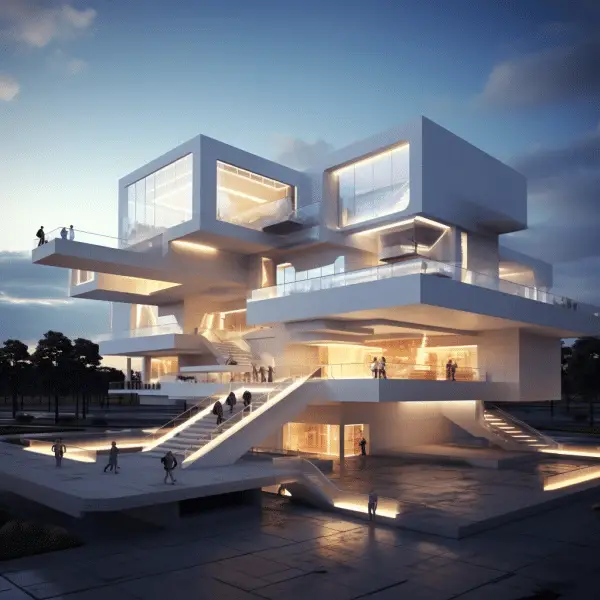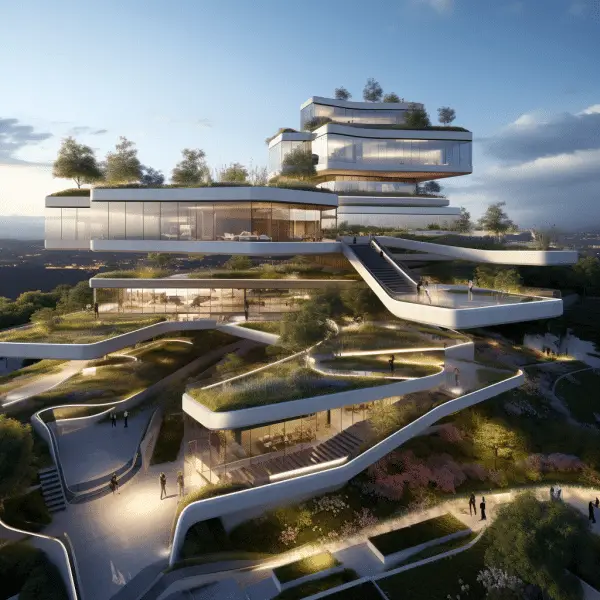Architectural Design: Merging Creativity and Technical Expertise
Architectural design plays a crucial role in shaping the world we live in by merging creativity and technical expertise to create functional and aesthetically pleasing living spaces. It is the discipline that combines the art of design with the science of construction, resulting in structures that fulfill the needs and demands of individuals while enhancing the surrounding environment.
Geometry, space, and aesthetics are important to architectural design. Architectural considerations include user needs, available resources, and material and construction technology. Architects design useful, sustainable, and attractive spaces by taking these factors into account.
Each architectural design has its own style and approach. Biophilic design uses natural light, plants, and open areas to enhance well-being. Minimalist design emphasizes clean lines and fewer embellishments to maintain order. Victorian design features complex detailing and historical influences from the Victorian era’s opulent and beautiful styles.
Design architects are crucial to architectural design. They create construction blueprints, comprehensive drawings, and specifications. Design architects work with clients and other experts to create functional designs that bring environments to life.
| Key Takeaways: |
|---|
| Architectural design combines creativity and technical expertise to create functional and aesthetically pleasing living spaces. |
| The process of architectural design involves analyzing factors such as needs, resources, aesthetics, and technical characteristics. |
| Types of architectural design include biophilic design, minimalist design, and Victorian design. |
| Design architects are responsible for creating project plans, drawings, and specifications. |

Elements of Architectural Design
Architectural design includes geometry, space utilization, and aesthetics, which are essential to good living places. Architects use these characteristics to create buildings that suit people’s needs and look good.
Geometry is crucial to architecture. Mathematical principles and accurate measurements help architects design harmonic and balanced structures. Geometry helps turn creative thoughts into physical structures, whether it’s a traditional building’s symmetrical lines or a modern design’s inventive curves.
Space utilization is another important architectural design element. Architects assess space and determine how to use it for functionality. Thoughtful space planning is vital for effective and enjoyable settings, whether it’s improving a small apartment’s efficiency or creating open and flexible commercial facilities.
The aesthetics of architectural design focus on a structure’s appearance. Architects use color, materials, textures, and lighting to create stunning designs. By carefully selecting and combining these elements, architects can create specific emotions and improve user and occupant experiences.
Table: Elements of Architectural Design
| Element | Description |
|---|---|
| Geometry | The use of mathematical principles and precise measurements to create balanced and harmonious structures. |
| Space Utilization | The strategic planning and arrangement of space to optimize functionality and efficiency. |
| Aesthetics | The consideration of visual appeal through color, materials, textures, and lighting to create an engaging experience. |
Types of Architectural Design
In the world of architectural design, various styles and approaches exist, such as the nature-inspired biophilic design, the simplicity of minimalist design, and the nostalgic charm of Victorian design. Each type of architectural design brings its own unique characteristics and influences the way spaces are created and experienced.
Biophilic design is an approach that seeks to connect people with nature. It incorporates natural elements, such as plants and natural lighting, into the built environment. This design style aims to enhance well-being and productivity by creating spaces that evoke a sense of calmness and a connection to the natural world.
Minimalist design is characterized by simplicity, clean lines, and a focus on functionality. It embraces the concept of “less is more” and eliminates unnecessary ornamentation. Minimalist design aims to create spaces that are uncluttered and promote a sense of calm and tranquility.
Victorian design draws inspiration from the architecture of the Victorian era, which spanned from the mid-19th century to the early 20th century. This style is known for its intricate detailing, ornate decorations, and grandeur. Victorian design often features elements such as multiple gables, decorative trim, and stained glass windows, creating a sense of opulence and elegance.
Victorian design often features elements
| Design Type | Main Characteristics |
|---|---|
| Biophilic Design | Nature-inspired, incorporates natural elements, promotes well-being |
| Minimalist Design | Simplicity, clean lines, focus on functionality |
| Victorian Design | Intricate detailing, ornate decorations, grandeur |
Each type of architectural design brings its own unique flavor and offers different experiences. Whether it’s the calming connection to nature in biophilic design, the simplicity and functionality of minimalist design, or the nostalgic charm of Victorian design, architectural design plays a vital role in shaping our built environment. From the materials used to the spatial layout, every aspect is carefully considered to create spaces that are aesthetically pleasing, functional, and suited to the needs of the individuals who inhabit them.
The Role of Design Architects
Architecture relies on design architects to create project designs, comprehensive drawings, and building needs. Their specialty is combining creativity and technical competence to create settings that satisfy people’s needs.
Design architects consider the client’s needs, resources, and aesthetic and technological preferences while starting a new project. They carefully plan the building’s layout, functioning, and aesthetics to match the client’s concept and meet building codes.
Design architects use project blueprints, precise drawings, and specifications to explain their design intent. These documents manage the construction process, ensuring that every detail, from structural elements to interior finishes, is carefully planned and performed.
| Responsibilities of Design Architects |
|---|
| Developing project plans |
| Creating detailed drawings |
| Specifying requirements for construction |
Working with a design architect
Collaboration with a design architect can boost architectural project success. Their ability to combine aesthetics and technical understanding guarantees that the final design fits customer needs and safety and regulatory norms. Design architects use creativity, problem-solving, and a comprehensive grasp of the built environment to create useful and beautiful structures.
Design architects are essential to architectural design because they turn ideas into reality. They combine creativity and technological competence to design functional and attractive buildings that satisfy people’s requirements. Design architects methodically plan and execute every component of the building by creating project plans, precise drawings, and construction specifications. Using a design architect can help an architectural project succeed by making it look good and meet safety and regulatory criteria.
The Architectural Design Concept
The architectural design concept acts as a guiding principle, shaping the overall vision and framework of a project, ensuring cohesion and harmony in the final result. It is the core idea that drives the design process and provides a clear direction for the architects and designers involved.
When developing an architectural design concept, several factors come into play. The needs and requirements of the client, the site’s characteristics, and the project’s objectives are carefully analyzed and considered. The concept serves as a blueprint, outlining the design’s key elements and defining the project’s identity.
With the architectural design concept in place, architects can begin the creative process. They explore different design options, evaluating how each one aligns with the concept and the desired outcome. This exploration allows for the integration of technical expertise and innovative approaches, leading to unique and visually appealing designs.
| Key Elements of the Architectural Design Concept | Description |
|---|---|
| Theme | The underlying theme or narrative that informs the design concept and creates a cohesive story throughout the project. |
| Form | The physical shape and structure of the building, which should reflect the project’s purpose and functionality. |
| Materials | The choice of materials used in the design, considering their aesthetic qualities, durability, and sustainability. |
| Color Palette | The selection of colors that contribute to the overall atmosphere and mood of the project. |
By clearly defining the architectural design concept and its key elements, architects can effectively communicate their vision to clients, stakeholders, and construction teams. This ensures that everyone involved in the project understands and works towards the same goal, resulting in a successful and harmonious final product.
The Architectural Design Process
The architectural design process involves several stages, starting from pre-project preparation to design development, culminating in construction documentation and the actual construction phase. Each stage plays a crucial role in the creation of a successful architectural design.
1. Pre-project preparation: This initial stage sets the foundation for the entire design process. Architects conduct thorough research and gather relevant information about the project, including site analysis, client requirements, and regulatory constraints. It is at this stage that the architect identifies the goals, objectives, and scope of the project.
2. Design development: With a clear understanding of the project’s requirements, architects move on to the design development stage. This is where the creative process takes shape, and architects explore different design options. They develop conceptual drawings, create 3D models, and collaborate with clients to refine the design based on their feedback.
3. Construction documentation: Once the design concept is finalized, architects begin documenting the technical aspects of the project. They create detailed architectural drawings, construction plans, and specifications that communicate the design intent to contractors and builders. These documents serve as a guide for the actual construction phase.
4. Construction: The final stage of the architectural design process involves the actual construction of the building. Architects work closely with contractors and project managers to ensure that the design is implemented accurately. They visit the construction site, monitor progress, and address any design-related issues that may arise during the construction process.
By following this structured approach, architects are able to deliver well-designed and functional spaces that meet the needs and aspirations of their clients. The architectural design process is a meticulous journey that combines technical expertise, creativity, and careful planning to bring visionary ideas to life.
Architectural design process
| Stage | Description |
|---|---|
| Pre-project preparation | Identifying goals, requirements, and scope of the project. |
| Design development | Creating and refining the design concept. |
| Construction documentation | Producing technical drawings, plans, and specifications. |
| Construction | Overseeing the actual construction process. |
Architecture vs. Architectural Design
Architectural design focuses on specific design elements to create unique and functional structures. Through their skill and imagination, architects carefully analyze geometry, space, and aesthetics to form our environment. Architectural design is essential in turning abstract ideas into tangible environments, whether it’s a sustainable biophilic building that integrates with nature or an attractive Victorian-style building that honors history.
Architecture involves designing and creating structures with functionality, aesthetics, and structural integrity in mind. It entails examining site characteristics, comprehending cultural contexts, and merging engineering and interior design to create a unified and practical architectural solution.
Architectural design, however, concentrates on building design. It uses technical competence and artistic vision to create project-specific designs. Architects collaborate with clients to design around budget, sustainability, and construction codes.
Architectural design is vital for creating spaces that inspire and improve the lives of its users. Innovation and utility are combined in this field, ensuring practicality and usage. We may design buildings that represent culture and human achievement as well as physical constructions.
| Architecture | Architectural Design |
|---|---|
| Encompasses the broader practice of building design | Focuses specifically on the design process of a building or structure |
| Considers functionality, aesthetics, and structural integrity of the entire project | Combines technical expertise and artistic vision to produce designs that meet specific requirements |
| Analyzes site conditions, cultural contexts, and incorporates various disciplines | Works closely with clients to consider their needs, desires, and other factors such as budget and sustainability |
The Environmental Aspect in Architectural Design
Modern architects try to incorporate sustainable and eco-friendly features into their designs, making environmental consideration imperative. The urgent need to reduce our carbon footprint and protect our planet drives the shift toward ecologically responsible design. Architects know that their buildings affect energy use, waste, and occupant health.
Architectural design may boost environmental sustainability. Solar panels and geothermal heating can help architects cut fossil fuel use and greenhouse gas emissions. Sustainable materials and construction methods reduce waste, conserve resources, and improve indoor air quality.
Additionally, architects are using biophilic architecture to link people to nature and improve well-being. Green roofs, natural lighting, and inside plants improve a building’s aesthetics, air quality, noise reduction, and productivity. When architects include nature into their designs, they foster harmony between humans and nature.
Finally, environmental considerations in architectural design are now a key principle that governs the building of sustainable, eco-friendly, and beautiful spaces. Architects may improve future generations’ quality of life by adopting environmentally friendly design principles.

Conclusion
Architectural design is a vital discipline that merges creativity and technical expertise to mold the world we live in, creating functional and visually appealing living spaces. It combines the use of tools and imagination to merge technology and aesthetics, resulting in the creation of buildings that fulfill the needs and demands of individuals.
The architectural design process involves analyzing and considering various factors such as geometry, space, and aesthetics. Design architects play a crucial role in this process, as they are responsible for creating project plans, drawings, and specifications for buildings. These professionals must carefully assess needs, resources, aesthetics, and technical characteristics to produce designs that are both practical and visually pleasing.
There are different types of architectural design, including biophilic design, minimalist design, and Victorian design. Each type embraces its own set of principles and values, offering unique perspectives on how living spaces can be designed and experienced.
As the core idea that guides a project, the architectural design concept serves as the foundation for its development. It provides the framework for the design process, ensuring that all aspects of the project align with the overall vision. From pre-project preparation to design development, construction documentation, and construction itself, the architectural design process involves multiple stages that require careful planning, collaboration, and attention to detail.
Pre-project preparation
It is important to differentiate between architecture and architectural design. While architecture encompasses the broader practice of building design, architectural design specifically focuses on the creation of a particular object or structure. By recognizing this distinction, we can better understand the complexities and nuances involved in the creation of functional and visually striking living spaces.
Furthermore, in a world that is increasingly aware of the importance of sustainability, architectural design plays a crucial role in considering the environmental aspect. Architects are challenged to incorporate sustainable and eco-friendly approaches in their designs, ensuring that buildings are not only aesthetically pleasing but also environmentally responsible.
In conclusion, architectural design is a dynamic discipline that shapes our surroundings. Through the fusion of creativity and technical expertise, architects contribute to the creation of living spaces that are not only functional but also visually captivating. The careful consideration of factors such as geometry, space, aesthetics, and sustainability ensures that architectural designs meet the needs of individuals while harmonizing with the environment. As we continue to advance, architectural design will continue to evolve, reflecting the ever-changing needs and aspirations of society.
FAQ
Q: What is architectural design?
A: Architectural design is the discipline that combines creativity and technical expertise to create living spaces that fulfill the needs and demands of individuals. It involves the use of tools and creativity to merge technology and aesthetics.
Q: What are the elements of architectural design?
A: The elements of architectural design include geometry, space, and aesthetics. Architects analyze and consider factors such as needs, resources, aesthetics, and technical characteristics when designing.
Q: What are the different types of architectural design?
A: There are various types of architectural design, such as biophilic design, minimalist design, and Victorian design. Each type has its unique characteristics and design principles.
Q: What is the role of design architects?
A: Design architects are responsible for creating project plans, drawings, and specifications for buildings. They work closely with clients to understand their needs and translate them into functional and aesthetically pleasing designs.
Q: What is the architectural design concept?
A: The architectural design concept is the core idea that guides a project and provides the framework for its development. It encapsulates the overall vision and goals of the design, shaping the final outcome.
Q: What are the stages in the architectural design process?
A: The architectural design process involves stages such as pre-project preparation, design development, construction documentation, and construction. Each stage is crucial for ensuring the successful realization of the design.
Q: What is the difference between architecture and architectural design?
A: The difference lies in the broader practice of architecture, which encompasses the entire process of building design and construction, whereas architectural design focuses specifically on creating a particular object or structure.
Q: How does environmental aspect play a role in architectural design?
A: Considering the environmental aspect in architectural design is crucial for promoting sustainable and eco-friendly approaches. Architects strive to minimize the negative impact of buildings on the environment and incorporate sustainable design principles.
Q: Is there a conclusion to this article?
A: No, there is no conclusion section in this article. The key points discussed throughout emphasize the importance of architectural design in shaping our surroundings.








